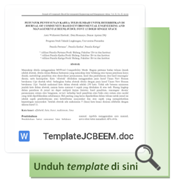Relationship between Pollutant Sources and Water Quality of Dug Well Based on Biological Parameters of E. Coli
DOI:
https://doi.org/10.23969/jcbeem.v6i2.6087Keywords:
cow shed, dug well, Escherichia Coli (E.Coli), septic tankAbstract
Water from dug wells is one of the sources of clean water used by the community both in villages and cities. Groundwater consumed by the community must have quality in accordance with the specified requirements. One of the important parameters is the presence of Escherichia coli bacteria (E.coli). The aims of this study is to identify the presence of Escherichia coli bacteria in dug well. In addition, to determine the correlation between the distance of the pollutant source (cowshed and septic tank) and the well. The analytical method used is univariate descriptive method and quantitative analysis. The results showed from 7 wells that were used as research objects, there were 4 wells positive for E. Coli bacteria and 3 wells were negative for E. Coli bacteria. The correlation value test showed that the pollutant source from cowshed had a coefficient of determination of R 2 = 0.911 or 91.1% which means that there is a strong relationship between the presence of E.Coli bacteria in the well and cow dung. As for the pollutant source from the septic tank, the results of the correlation test show the value of R 2 = 0.201 or 20.1% which means that the relationship between the presence of E. Coli bacteria and the septic tank is not strong. Septic tanks construction that conform to standards are one of the factors that cause dug well water quality to remain protected from pollutants.
Downloads
References
Blum, H, L. (1974). Planning for Health: Development Application of Social Change Theory. New York.
Chin, WW. (1998). The Partial Least Squares Aproach to Structural Equation Modeling. Modern Methods for Business Research. Modern Methods for Busines Research, 295-336
Chandra, B. (2006). Pengantar Ilmu Kesehatan Lingkungan. Jakarta : Penerbit Buku Kedokteran
Decree of the Minister of Health No. 492 of 2010. Drinking Water Quality Requirements.
Marsono. (2009) . Factors Related to the Bacteriological Quality of Dug Well Water in the Karanganom Village Settlement, North Klaten District, Klaten Regency . Thesis. Semarang : Diponegoro University.
SNI 03-2916-1992, Specification of dug wells for clean water sources
Soemirat, J. (2011) . Kesehatan Lingkungan . Revision. Yogyakarta: Gadjah Mada University Press
Yustiani, Y.M., Hasbiah, A.W., Fuad, R. (2017). Pengaruh Kondisi Fisik Dan Jarak Sumur Gali Dengan Peternakan Sapi Terhadap Kandungan Bakteri Coliform Air Sumur Gali Di Desa Sukajaya Kecamatan Lembang Kabupaten Bandung Barat. Journal of Community Based Environmental Engineering and Management, 1(1), 19-24.
Tutut Mugi Rahayu. (2015). Study Clean Water Quality of Dug Wells in Japun Hamlet, Kewangunan Village, Petanahan District, Kebumen Regency, 2014. Scientific Paper. Purwokerto : Health Polytechnic of the Ministry of Health Semarang Department of Environmental Health Purwokerto.
Nurhadini. (2016). Studi Deksriptif Sumur Gali Ditinjau dari Kondisi Fisik Lingkungan dan Praktik Masyarakat di Kabupaten Boyolali. Undergraduate Thesis. Universitas Negeri Semarang.
Wirawaty. (2012). Gambaran Perilaku Penggunaan, Kondisi Fisik Serta Uji Bakteriologis Pada Air Sumur Gali Di Desa Haya-haya Kecamatan Limboto Barat Kabupaten Gorontalo Tahun 2012. Undergraduate Thesis., Universitas Negeri Gorontalo.














